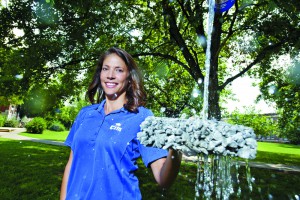MTSU’s first-of-its-kind Concrete Industry Management Department keeps its grads in the mix.
By Bill Lewis

Set in Concrete: MTSU Concrete Industry Management director Heather Brown demonstrates how pervious concrete allows water to seep through it.
Students and professors in one of MTSU’s newest graduate degree programs will live and work a long way from any academic ivory towers. Successful students who graduate from MTSU’s first-of-a-kind M.B.A. program with a specialization in Concrete Industry Management (CIM) will have active careers in the global, high-growth, science-driven concrete industry.
Faculty members in the Jennings A. Jones College of Business who will teach graduate-level CIM MBA classes are already getting hands-on experience in preparation for the program. Each will spend one to two weeks in the field as a faculty intern, learning the science and unique management practices behind the evolving industry.
“Those willing to get their hands dirty fare better” in concrete industry careers, says Mike Schneider, chair of the industry’s National Steering Committee (NSC), which worked with CIM Chair Heather Brown and others at MTSU to develop the yet-to-be-approved M.B.A. program, which is recruiting its initial class of 25 students and aiming for a fall 2012 launch. Each participant must have at least five years of industry experience.
The NSC collaborated with MTSU to begin the University’s then-unique undergraduate CIM program in 1996. Earlier this year, CIM was established as the tenth department in the College of Basic and Applied Sciences under Brown’s leadership. It’s all part of an effort to foster sustainability and a deeper institutional memory in an industry crucial to the global economy but in which skills have traditionally been passed from one generation of workers to another—even among those with advanced degrees—through on-the-job experience, not university classrooms.
The business “is still a good-old-boy industry on a local level, but the ready-mix truck is only part of the end product,” Brown says. “The cement industry is an international powerhouse.”
MTSU’s program is a powerhouse as well, especially when it comes to research. The program is working with a few companies on projects that include determining if a Tennessee-mined kaolin clay is suitable for concrete once mined, burned, and crushed into metakaolin; investigating the long-term durability and bond strength of thin overlay systems for bridge decks and highway applications; comparing different curing methods and products for pervious concrete to determine if plastic sheeting can be eliminated; conducting testing on three manufactured fibers and one recycled fiber for use in pervious concrete to increase freeze/thaw resistance and abrasion resistance; and validating strength and absorption benefits of a colloidal silicate densifier for interior polished floors (just to name a few). Importantly, much of the research produced by CIM is completed by undergraduate students and in time intervals that match the speed of the ever-evolving concrete industry.
Armed with such cutting-edge study and research, the 500 graduates of MTSU’s undergraduate CIM program fill industry positions in 30 states, where they work as researchers, executives, contractors, managers of production facilities and in sales and other positions, among other positions.
“It’s not an industry people historically thought of as glamorous,” Brown says. “But the industry is changing its image.”
Indeed, 80 percent of the graduates of MTSU’s program are still in the industry despite the recession, which left innumerable construction projects on the drawing board and, says the NSC’s Schneider, cut in half the amount of concrete produced in the U.S. from 450 million cubic yards in 2007 to just 225 million last year.
Ironically, the industry’s troubles are expected to create opportunities for MTSU’s CIM graduates, says the NSC’s David Vickers, who chairs the committee organizing the M.B.A. program.
Many “old hands” have retired or left the industry, and those positions will need to be filled when economic recovery arrives.
“The importance of the [CIM] program to the industry will be as the recovery takes place. They’ll have undergraduates in place and high-level M.B.A. [participants] to rely on,” Vickers says. “The opportunities for graduates are going to be spectacular.”
Many of the M.B.A. classes are expected to be offered through distance learning with occasional visits to the University. While on campus, M.B.A. participants eventually will be able to join the 350 undergraduates in the CIM Department’s own building, which is in the early planning stage. Fundraising for the building’s projected $7 million price tag is in progress, with naming rights to the building and many of its rooms set at different contribution levels..
Understandably, the 22,000-square-foot, two-story building will showcase different types of concrete construction. One room may have a stained and polished floor while another may have a floor stamped with a design. Windows will expose the interiors of the walls so students can see how they were built. The driveway and walkways will be made of concrete. Care will be taken to ensure that the building complements the campus, where most buildings are brick.
“It will look like brick to match the campus, but it will be concrete,” Brown says. “The idea is to show what we can do.”
What CIM can do, it turns out, is both greatly benefit the concrete industry and also cement the professional prospects of the graduates it produces.

COMMENTS ARE OFF THIS POST